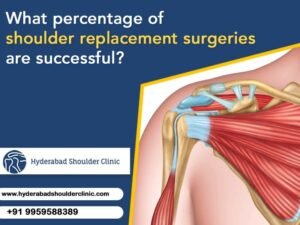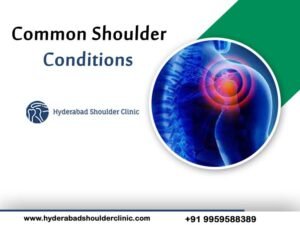Frozen shoulder: The bones, ligaments, and tendons that make up your shoulder joint encased in a capsule of connective tissue. Frozen shoulder occurs when this capsule thickens and tightens around the shoulder joint, restricting movement.
What is Frozen Shoulder?
Frozen shoulder is also known as adhesive capsulitis, is a condition characterized by stiffness and pain in your shoulder joint. Signs and symptoms typically begin gradually, worsen over time and then resolve, usually within one or three years.

Your risk of developing frozen shoulder increases, when you are moving the head in medical illness.
Treatment for frozen shoulder involves:
- Range of motion exercise
- Sometimes, corticosteroids
- Numbing medications injected into the joint capsules.
In this procedure, the joint capsule is loosened so that it can move more freely.
- It is unusual for a frozen shoulder to recur in the same shoulder joint, but some people can develop it in the opposite shoulder.
The treatment options for frozen shoulder is depending on the symptoms appearing. These symptoms typically develop slowly, in three stages. Namely, they are:
- Freezing stage
- Frozen shoulder
- Thawing

1. Freezing stage: (6 weeks to 6 months)
- As the name suggests, the shoulder capsule starts thickening/freezing. As the capsule begins thickening, movements of the shoulder get extremely painful and difficult.
- During this phase, the motion of the shoulder isn’t restricted much, albeit the patient senses not being able to make a complete range of motion of the shoulder. This is the reason for the frozen shoulder often being misdiagnosed as a problem with the rotator cuff.

2. Frozen Stage(4 months to 6 months):
The second phase of the frozen shoulder is known as The Frozen Phase. The patient during this phase shall experience the shoulder being stiff. It is during this stage that a definitive diagnosis can be made, differentiating frozen shoulder from rotator cuff syndrome. In rotator cuff syndrome, a patient has trouble moving his/her arm, but someone a doctor or an examiner can manipulate the arm and move it. Whereas in a frozen shoulder, neither the patient nor the doctor/examiner can move the shoulder joint.
Pain during this phase is not as excruciating as in the earlier phase, but pain may emanate from performing simple activities. Since the rotation of the shoulder joint is limited, performing day-to-day activities such as washing hair, donning and doffing of clothes, reaching for a seat belt, etc.

Care should be taken to perform stretching exercises slowly to stretch the shoulder capsule and even allow for some discomfort to ensure recovery of the lost shoulder joint mobility.

3. Thawing (6 months to 2 years):
During the phase of the frozen shoulder, the capsule of the shoulder joint appears thick and rigid, but over time, it gradually loosens.
Thawing phase is a comfortable phase, from a patient’s standpoint, for someone suffering from frozen shoulder, since during this phase, the pain starts dissipating and the motion of the shoulder joint starts improving, giving hope for the patient.
Finally, the shoulder thaws, the range of motion begins to improve but some pain remains same and the frozen hand becomes completely normal.
Conclusion:
Frozen shoulder goes through phases before the patient is completely relieved of his pain and lack of motion, although it takes time. The key to driving away frozen shoulder is to perform exercises gradually and not be afraid of pain since pain limits the patient from performing the necessary and vital exercises.
Dr Chandrasekhar will probe you some questions and diagnose the frozen shoulder problem and help you with effective treatment options to get rid of this shoulder condition.





